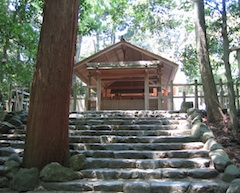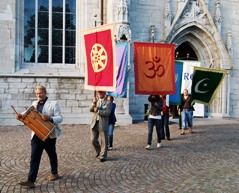|
|
|
|
 |
|
Religious Forests
 |
 |
 |
Shinto shrines protect some of Japan’s most ancient forests, dwelling place of the kami, the nation’s deities. The most famous is the Ise Grand Shrine. |
Many legends and religious stories are associated with trees: the Buddha is said to have meditated for years beneath a bho tree now called a ‘bodhi tree’ or ficus religiosa. The yew in pre-Christian and Christian Britain is believed to protect those who shelter beneath it. The fact that trees are crucial to a healthy natural environment is one reason they are sacred within the great faiths.
Faith views and practices have an enormous impact on the state of the world's forests. For a start the faiths own and manage large areas of forest worldwide, from huge commercial woodlands to tiny sacred groves.
They also influence much more - land that is not necessarily owned by faith communities but is considered sacred. Oxford University researchers estimate that about 15% of the world’s surface is ‘sacred land’. ARC/WWF research has found that sacred land generally has high levels of biodiversity thanks to the protection from development provided by its sacred status.
For an example of how the efforts of one faith group - Buddhist monks - to protect Cambodia's biggest community forest were recognised with the prestigious UN award, the Equator Prize, in 2010, click here.
International Religious Forestry Standard
ARC is working with faith groups around the world to help them manage forests in ways that are in line with their values and beliefs.
With Japanese Shintos and Swedish Lutherans, as well as WWF, FSC and others, ARC is working to establish international standards for religious-owned forestry. The programme was launched in Gotland, Sweden, at a meeting in late August 2007. It is hoped that it will result in millions of hectares of religious forestry being managed in an environmentally sustainable way.
 |
 |
 |
Banners of the faiths. Visby Faiths and Forests Gathering 2007. Photo: Ben Campbell CI. |
Download a leaflet about ARC's Religious Forestry programme here.
Mapping sacred forests
ARC is working with Oxford University's Biodiversity Institute, in partnership with the World Database on Sacred Natural Sites, to help map the extent of sacred forests worldwide, as a vital first step to ensuring the faiths' role in protecting forests is recognised.
For more information, visit our Mapping Sacred Forests page.
Other Forest Programmes
Yews for the Millennium was launched by the Conservation Foundation to preserve ancient British yews.
In France, Sacred Land worked with a community of Orthodox nuns to preserve their forest as an eco-system.
In Japan, ARC is working with Shinto leaders to preserve their sacred groves, and shift to FSC-equivalent timber for their temples.
In an unprecedented move, the Church of Sweden
agreed in 2000 to move towards certifying 15 per cent of its forests – more than 100,000 hectares – as sustainably managed under the Forestry Stewardship Council (FSC) guidelines.
Hindu groups and the Orissa government have agreed, under the Sacred Gifts programme, to re-establish the state’s sacred forests to provide sustainably-managed wood for the annual festival of Lord Jagannath.
Further forestry links
Keynote speech about faiths and forestry
Yews for the Millennium
The Solan community of Orthodox nuns
FSC
Skogforsk - the Forestry Research Institute of Sweden.
Video about forests - their history and their future
UN FAO's Regional Forestry Commission
Royal Forestry Society.
Canadian Forestry Association
Center for International Forestry Research
The Rainforest Alliance
Commonwealth Forestry Association
|
 |
|
|
|
|
|

